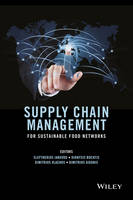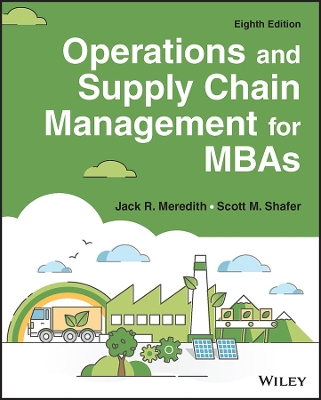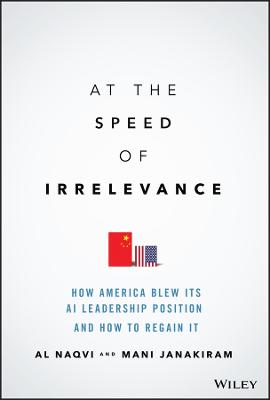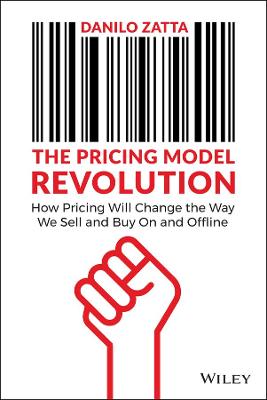Supply Chain Management for Sustainable Food Networks
 -15%
portes grátis
-15%
portes grátis
Supply Chain Management for Sustainable Food Networks
Vlachos, Dimitrios; Aidonis, Dimitrios; Iakovou, Eleftherios; Bochtis, Dionysis
John Wiley & Sons Inc
01/2016
328
Dura
Inglês
9781118930755
15 a 20 dias
508
Descrição não disponível.
Notes on Contributors ix
Preface xvii
Acknowledgments xxiii
1 Sustainable Agrifood Supply Chain Management 1
1.1 Introduction - Agrifood Supply Chain Management 1
1.2 Why Sustainable Agrifood Supply Chain Management 5
1.3 Hierarchy of Decision-Making for AFSCs 10
1.3.1 Strategic Level 10
1.3.2 Tactical and Operational Levels 17
1.4 Emerging Trends and Technologies in Primary Production 21
1.4.1 Alternative Production Systems 21
1.4.2 Innovative Technologies 23
1.5 Conclusions 25
2 Precision Agriculture: Crop Management for Improved Productivity and Reduced Environmental Impact or Improved Sustainability 41
2.1 Introduction 41
2.2 How Precision Agriculture is Applied 43
2.2.1 Data Collection 43
2.2.2 Data Analysis and Management Zone Delineation 51
2.2.3 Variable Rate Application Technology 52
2.2.4 Auto Guidance Systems and Other Applications 56
2.3 Decision Support Systems for the Farmer 57
2.4 Profitability and Adoption of Precision Farming 57
2.5 Precision Agriculture and Sustainability 59
2.6 Conclusions 60
3 Agricultural Waste Biomass 67
3.1 Introduction 67
3.2 Amount of Biomass 68
3.2.1 Global Production of Agricultural Residues 69
3.2.2 China 76
3.2.3 Denmark 81
3.2.4 USA 83
3.3 Biorefinery Processing of Agricultural Waste Products 86
3.3.1 Physiochemical Properties and Organic Composition of Agricultural Waste and Residue 86
3.3.2 Bioenergy Production 87
3.3.3 Bio?-based Chemical Production 89
3.4 Environmental and Land Use Issues 90
3.4.1 Manure Management 91
3.4.2 Crop Residues Management 95
3.4.3 Land Use Aspects 96
3.4.4 Whole Chain Management 97
3.5 Conclusion 98
4 Maintaining Momentum: Drivers of Environmental and Economic Performance, and Impediments to Sustainability 107
4.1 Introduction 107
4.2 Literature Review 109
4.3 Hypothesis Development 110
4.3.1 The Link between Stakeholder Demands and Integration of Environmental Activities 110
4.3.2 The Link between Integration and Economic and Environmental Performance 111
4.3.3 The Role of Moderating Factors 112
4.4 Data and Method 114
4.4.1 Sample Description 114
4.4.2 Variable Descriptions 115
4.4.3 Statistical Estimation 117
4.5 Results 117
4.6 Discussion and Conclusions 122
5 A Hierarchical Decision?-Making Framework for Quantitative Green Supply Chain Management: A Critical Synthesis of Academic Research Efforts 129
5.1 Introduction 130
5.2 Hierarchy of the Decision?]Making Process 131
5.2.1 Strategic GSCM Decisions 131
5.2.2 Tactical GSCM Decisions 138
5.2.3 Operational GSCM Decisions 142
5.3 Critical Synthesis of Academic Research Efforts 146
5.4 Summary and Conclusions 151
6 Safety and Traceability 159
6.1 Introduction 159
6.2 Drivers for Food Traceability 160
6.3 Traceability: Legislations and Standards 163
6.3.1 International Legislation 163
6.3.2 Standards 166
6.4 Design of Traceability Systems 167
6.4.1 Definitions of Traceability Related Concepts 167
6.4.2 Current Technologies for Traceability 169
6.4.3 Performance Optimization 171
6.5 Future Trends 174
6.6 Conclusions 176
7 Information Technology for Food Supply Chains 183
7.1 Introduction 183
7.2 Information Technology Architecture in a Supply Chain Context 184
7.3 RFID?-Enabled Supply Chain Management 186
7.4 Carbon Footprint Monitoring in the Supply Chain 191
7.5 Urban Shared Food Logistics 194
7.6 Discussion 199
7.7 Conclusions 200
8 Carbon Footprint Management for Food Supply Chains: an Integrated Decision Support System 205
8.1 Introduction 205
8.2 The Carbon Footprint of Food Supply Chains 207
8.2.1 Background 207
8.2.2 Carbon Footprint of Pre?]farm Processes 209
8.2.3 Carbon Footprint of On?]farm Processes 209
8.2.4 Carbon Footprint of Post?]farm Processes 210
8.2.5 Critical Challenges of CFM 214
8.3 The Supply Chain Environmental Analysis Tools 215
8.3.1 The Need for New Tools 215
8.3.2 Description of Methodological Approach 216
8.4 An Illustrative Case Study 218
8.4.1 Scenario Description 218
8.4.2 Application and Analysis of SCEnAT Tools 220
8.4.3 Implication of SCEnAT Tools in a Wheat Supply Chain 223
8.5 Summary and Conclusions 224
9 Quality Management Schemes and Connections to the Concept of Sustainability in the Food Chain 233
9.1 Introduction 233
9.2 Quality Management Schemes in the Food Supply Chain 234
9.2.1 Food Quality Definitions 234
9.2.2 Quality Management Scheme Concepts 235
9.2.3 Application of Quality Management Schemes to the Supply Chain 238
9.2.4 Beneficiaries of Quality Management Schemes along the Supply Chain 239
9.3 Introducing Sustainability and Sustainable Production 239
9.4 Linking Quality Management Schemes with Sustainability along the Food Chain 242
9.4.1 Primary Production 244
9.4.2 Food Manufacturing 244
9.4.3 Transportation and Food Retailing 248
9.5 Consumers and Quality Management Schemes Addressing Sustainability 249
9.6 Conclusion 251
10 Risk Management for Agri-food Supply Chains 255
10.1 Introduction 255
10.2 Supply Chain Risk Management 259
10.2.1 Improving Security 260
10.2.2 Facing Disruptions 261
10.3 Risk Management in Agri?-food Supply Chains 262
10.3.1 Risk Types and Sources 262
10.3.2 Risk Mitigation Strategies 263
10.3.3 Quantitative Tools for Agri-food Supply Chain Risk Management 265
10.4 Case 1: Revenue Management of Perishable Agri-food Products - a Newsvendor-Type Modeling Approach 265
10.4.1 System Description 266
10.4.2 Model Development 267
10.4.3 Numerical Example 270
10.5 Case 2: Emergency Dual Sourcing Contracts - a Simulation-Based Approach 271
10.5.1 System Description 272
10.5.2 Discrete Event Simulation Model 274
10.5.3 Numerical Example 276
10.6 Case 3: Managing Agri?-food Supply Chain Disruption Risks - a Game?-Theoretic Approach 279
10.6.1 Model and Problem Description 280
10.6.2 Study of Game Interactions 281
10.6.3 Numerical Example 285
10.7 Conclusions 287
11 Regulatory Policies and Trends 293
11.1 Regulations as Tools 293
11.2 Environmental Externalities and Savings as Drivers of Regulations 295
11.3 Diversity as a Driver for Informal Regulations and Trends 297
11.4 Nutrition and Environmental Issues Regulated at the Food Plate Level 298
11.5 Citizens-Consumers Facing Regulations at the Market 299
11.6 Food Production as a Component of a Future Bioeconomy 301
11.7 Future Regionalism Related to Regulation 303
11.8 What is Needed for Regulatory Policy Development 304
Index 307
Preface xvii
Acknowledgments xxiii
1 Sustainable Agrifood Supply Chain Management 1
1.1 Introduction - Agrifood Supply Chain Management 1
1.2 Why Sustainable Agrifood Supply Chain Management 5
1.3 Hierarchy of Decision-Making for AFSCs 10
1.3.1 Strategic Level 10
1.3.2 Tactical and Operational Levels 17
1.4 Emerging Trends and Technologies in Primary Production 21
1.4.1 Alternative Production Systems 21
1.4.2 Innovative Technologies 23
1.5 Conclusions 25
2 Precision Agriculture: Crop Management for Improved Productivity and Reduced Environmental Impact or Improved Sustainability 41
2.1 Introduction 41
2.2 How Precision Agriculture is Applied 43
2.2.1 Data Collection 43
2.2.2 Data Analysis and Management Zone Delineation 51
2.2.3 Variable Rate Application Technology 52
2.2.4 Auto Guidance Systems and Other Applications 56
2.3 Decision Support Systems for the Farmer 57
2.4 Profitability and Adoption of Precision Farming 57
2.5 Precision Agriculture and Sustainability 59
2.6 Conclusions 60
3 Agricultural Waste Biomass 67
3.1 Introduction 67
3.2 Amount of Biomass 68
3.2.1 Global Production of Agricultural Residues 69
3.2.2 China 76
3.2.3 Denmark 81
3.2.4 USA 83
3.3 Biorefinery Processing of Agricultural Waste Products 86
3.3.1 Physiochemical Properties and Organic Composition of Agricultural Waste and Residue 86
3.3.2 Bioenergy Production 87
3.3.3 Bio?-based Chemical Production 89
3.4 Environmental and Land Use Issues 90
3.4.1 Manure Management 91
3.4.2 Crop Residues Management 95
3.4.3 Land Use Aspects 96
3.4.4 Whole Chain Management 97
3.5 Conclusion 98
4 Maintaining Momentum: Drivers of Environmental and Economic Performance, and Impediments to Sustainability 107
4.1 Introduction 107
4.2 Literature Review 109
4.3 Hypothesis Development 110
4.3.1 The Link between Stakeholder Demands and Integration of Environmental Activities 110
4.3.2 The Link between Integration and Economic and Environmental Performance 111
4.3.3 The Role of Moderating Factors 112
4.4 Data and Method 114
4.4.1 Sample Description 114
4.4.2 Variable Descriptions 115
4.4.3 Statistical Estimation 117
4.5 Results 117
4.6 Discussion and Conclusions 122
5 A Hierarchical Decision?-Making Framework for Quantitative Green Supply Chain Management: A Critical Synthesis of Academic Research Efforts 129
5.1 Introduction 130
5.2 Hierarchy of the Decision?]Making Process 131
5.2.1 Strategic GSCM Decisions 131
5.2.2 Tactical GSCM Decisions 138
5.2.3 Operational GSCM Decisions 142
5.3 Critical Synthesis of Academic Research Efforts 146
5.4 Summary and Conclusions 151
6 Safety and Traceability 159
6.1 Introduction 159
6.2 Drivers for Food Traceability 160
6.3 Traceability: Legislations and Standards 163
6.3.1 International Legislation 163
6.3.2 Standards 166
6.4 Design of Traceability Systems 167
6.4.1 Definitions of Traceability Related Concepts 167
6.4.2 Current Technologies for Traceability 169
6.4.3 Performance Optimization 171
6.5 Future Trends 174
6.6 Conclusions 176
7 Information Technology for Food Supply Chains 183
7.1 Introduction 183
7.2 Information Technology Architecture in a Supply Chain Context 184
7.3 RFID?-Enabled Supply Chain Management 186
7.4 Carbon Footprint Monitoring in the Supply Chain 191
7.5 Urban Shared Food Logistics 194
7.6 Discussion 199
7.7 Conclusions 200
8 Carbon Footprint Management for Food Supply Chains: an Integrated Decision Support System 205
8.1 Introduction 205
8.2 The Carbon Footprint of Food Supply Chains 207
8.2.1 Background 207
8.2.2 Carbon Footprint of Pre?]farm Processes 209
8.2.3 Carbon Footprint of On?]farm Processes 209
8.2.4 Carbon Footprint of Post?]farm Processes 210
8.2.5 Critical Challenges of CFM 214
8.3 The Supply Chain Environmental Analysis Tools 215
8.3.1 The Need for New Tools 215
8.3.2 Description of Methodological Approach 216
8.4 An Illustrative Case Study 218
8.4.1 Scenario Description 218
8.4.2 Application and Analysis of SCEnAT Tools 220
8.4.3 Implication of SCEnAT Tools in a Wheat Supply Chain 223
8.5 Summary and Conclusions 224
9 Quality Management Schemes and Connections to the Concept of Sustainability in the Food Chain 233
9.1 Introduction 233
9.2 Quality Management Schemes in the Food Supply Chain 234
9.2.1 Food Quality Definitions 234
9.2.2 Quality Management Scheme Concepts 235
9.2.3 Application of Quality Management Schemes to the Supply Chain 238
9.2.4 Beneficiaries of Quality Management Schemes along the Supply Chain 239
9.3 Introducing Sustainability and Sustainable Production 239
9.4 Linking Quality Management Schemes with Sustainability along the Food Chain 242
9.4.1 Primary Production 244
9.4.2 Food Manufacturing 244
9.4.3 Transportation and Food Retailing 248
9.5 Consumers and Quality Management Schemes Addressing Sustainability 249
9.6 Conclusion 251
10 Risk Management for Agri-food Supply Chains 255
10.1 Introduction 255
10.2 Supply Chain Risk Management 259
10.2.1 Improving Security 260
10.2.2 Facing Disruptions 261
10.3 Risk Management in Agri?-food Supply Chains 262
10.3.1 Risk Types and Sources 262
10.3.2 Risk Mitigation Strategies 263
10.3.3 Quantitative Tools for Agri-food Supply Chain Risk Management 265
10.4 Case 1: Revenue Management of Perishable Agri-food Products - a Newsvendor-Type Modeling Approach 265
10.4.1 System Description 266
10.4.2 Model Development 267
10.4.3 Numerical Example 270
10.5 Case 2: Emergency Dual Sourcing Contracts - a Simulation-Based Approach 271
10.5.1 System Description 272
10.5.2 Discrete Event Simulation Model 274
10.5.3 Numerical Example 276
10.6 Case 3: Managing Agri?-food Supply Chain Disruption Risks - a Game?-Theoretic Approach 279
10.6.1 Model and Problem Description 280
10.6.2 Study of Game Interactions 281
10.6.3 Numerical Example 285
10.7 Conclusions 287
11 Regulatory Policies and Trends 293
11.1 Regulations as Tools 293
11.2 Environmental Externalities and Savings as Drivers of Regulations 295
11.3 Diversity as a Driver for Informal Regulations and Trends 297
11.4 Nutrition and Environmental Issues Regulated at the Food Plate Level 298
11.5 Citizens-Consumers Facing Regulations at the Market 299
11.6 Food Production as a Component of a Future Bioeconomy 301
11.7 Future Regionalism Related to Regulation 303
11.8 What is Needed for Regulatory Policy Development 304
Index 307
Este título pertence ao(s) assunto(s) indicados(s). Para ver outros títulos clique no assunto desejado.
agri-food, supply chain management, networks, agriculture, economics
Notes on Contributors ix
Preface xvii
Acknowledgments xxiii
1 Sustainable Agrifood Supply Chain Management 1
1.1 Introduction - Agrifood Supply Chain Management 1
1.2 Why Sustainable Agrifood Supply Chain Management 5
1.3 Hierarchy of Decision-Making for AFSCs 10
1.3.1 Strategic Level 10
1.3.2 Tactical and Operational Levels 17
1.4 Emerging Trends and Technologies in Primary Production 21
1.4.1 Alternative Production Systems 21
1.4.2 Innovative Technologies 23
1.5 Conclusions 25
2 Precision Agriculture: Crop Management for Improved Productivity and Reduced Environmental Impact or Improved Sustainability 41
2.1 Introduction 41
2.2 How Precision Agriculture is Applied 43
2.2.1 Data Collection 43
2.2.2 Data Analysis and Management Zone Delineation 51
2.2.3 Variable Rate Application Technology 52
2.2.4 Auto Guidance Systems and Other Applications 56
2.3 Decision Support Systems for the Farmer 57
2.4 Profitability and Adoption of Precision Farming 57
2.5 Precision Agriculture and Sustainability 59
2.6 Conclusions 60
3 Agricultural Waste Biomass 67
3.1 Introduction 67
3.2 Amount of Biomass 68
3.2.1 Global Production of Agricultural Residues 69
3.2.2 China 76
3.2.3 Denmark 81
3.2.4 USA 83
3.3 Biorefinery Processing of Agricultural Waste Products 86
3.3.1 Physiochemical Properties and Organic Composition of Agricultural Waste and Residue 86
3.3.2 Bioenergy Production 87
3.3.3 Bio?-based Chemical Production 89
3.4 Environmental and Land Use Issues 90
3.4.1 Manure Management 91
3.4.2 Crop Residues Management 95
3.4.3 Land Use Aspects 96
3.4.4 Whole Chain Management 97
3.5 Conclusion 98
4 Maintaining Momentum: Drivers of Environmental and Economic Performance, and Impediments to Sustainability 107
4.1 Introduction 107
4.2 Literature Review 109
4.3 Hypothesis Development 110
4.3.1 The Link between Stakeholder Demands and Integration of Environmental Activities 110
4.3.2 The Link between Integration and Economic and Environmental Performance 111
4.3.3 The Role of Moderating Factors 112
4.4 Data and Method 114
4.4.1 Sample Description 114
4.4.2 Variable Descriptions 115
4.4.3 Statistical Estimation 117
4.5 Results 117
4.6 Discussion and Conclusions 122
5 A Hierarchical Decision?-Making Framework for Quantitative Green Supply Chain Management: A Critical Synthesis of Academic Research Efforts 129
5.1 Introduction 130
5.2 Hierarchy of the Decision?]Making Process 131
5.2.1 Strategic GSCM Decisions 131
5.2.2 Tactical GSCM Decisions 138
5.2.3 Operational GSCM Decisions 142
5.3 Critical Synthesis of Academic Research Efforts 146
5.4 Summary and Conclusions 151
6 Safety and Traceability 159
6.1 Introduction 159
6.2 Drivers for Food Traceability 160
6.3 Traceability: Legislations and Standards 163
6.3.1 International Legislation 163
6.3.2 Standards 166
6.4 Design of Traceability Systems 167
6.4.1 Definitions of Traceability Related Concepts 167
6.4.2 Current Technologies for Traceability 169
6.4.3 Performance Optimization 171
6.5 Future Trends 174
6.6 Conclusions 176
7 Information Technology for Food Supply Chains 183
7.1 Introduction 183
7.2 Information Technology Architecture in a Supply Chain Context 184
7.3 RFID?-Enabled Supply Chain Management 186
7.4 Carbon Footprint Monitoring in the Supply Chain 191
7.5 Urban Shared Food Logistics 194
7.6 Discussion 199
7.7 Conclusions 200
8 Carbon Footprint Management for Food Supply Chains: an Integrated Decision Support System 205
8.1 Introduction 205
8.2 The Carbon Footprint of Food Supply Chains 207
8.2.1 Background 207
8.2.2 Carbon Footprint of Pre?]farm Processes 209
8.2.3 Carbon Footprint of On?]farm Processes 209
8.2.4 Carbon Footprint of Post?]farm Processes 210
8.2.5 Critical Challenges of CFM 214
8.3 The Supply Chain Environmental Analysis Tools 215
8.3.1 The Need for New Tools 215
8.3.2 Description of Methodological Approach 216
8.4 An Illustrative Case Study 218
8.4.1 Scenario Description 218
8.4.2 Application and Analysis of SCEnAT Tools 220
8.4.3 Implication of SCEnAT Tools in a Wheat Supply Chain 223
8.5 Summary and Conclusions 224
9 Quality Management Schemes and Connections to the Concept of Sustainability in the Food Chain 233
9.1 Introduction 233
9.2 Quality Management Schemes in the Food Supply Chain 234
9.2.1 Food Quality Definitions 234
9.2.2 Quality Management Scheme Concepts 235
9.2.3 Application of Quality Management Schemes to the Supply Chain 238
9.2.4 Beneficiaries of Quality Management Schemes along the Supply Chain 239
9.3 Introducing Sustainability and Sustainable Production 239
9.4 Linking Quality Management Schemes with Sustainability along the Food Chain 242
9.4.1 Primary Production 244
9.4.2 Food Manufacturing 244
9.4.3 Transportation and Food Retailing 248
9.5 Consumers and Quality Management Schemes Addressing Sustainability 249
9.6 Conclusion 251
10 Risk Management for Agri-food Supply Chains 255
10.1 Introduction 255
10.2 Supply Chain Risk Management 259
10.2.1 Improving Security 260
10.2.2 Facing Disruptions 261
10.3 Risk Management in Agri?-food Supply Chains 262
10.3.1 Risk Types and Sources 262
10.3.2 Risk Mitigation Strategies 263
10.3.3 Quantitative Tools for Agri-food Supply Chain Risk Management 265
10.4 Case 1: Revenue Management of Perishable Agri-food Products - a Newsvendor-Type Modeling Approach 265
10.4.1 System Description 266
10.4.2 Model Development 267
10.4.3 Numerical Example 270
10.5 Case 2: Emergency Dual Sourcing Contracts - a Simulation-Based Approach 271
10.5.1 System Description 272
10.5.2 Discrete Event Simulation Model 274
10.5.3 Numerical Example 276
10.6 Case 3: Managing Agri?-food Supply Chain Disruption Risks - a Game?-Theoretic Approach 279
10.6.1 Model and Problem Description 280
10.6.2 Study of Game Interactions 281
10.6.3 Numerical Example 285
10.7 Conclusions 287
11 Regulatory Policies and Trends 293
11.1 Regulations as Tools 293
11.2 Environmental Externalities and Savings as Drivers of Regulations 295
11.3 Diversity as a Driver for Informal Regulations and Trends 297
11.4 Nutrition and Environmental Issues Regulated at the Food Plate Level 298
11.5 Citizens-Consumers Facing Regulations at the Market 299
11.6 Food Production as a Component of a Future Bioeconomy 301
11.7 Future Regionalism Related to Regulation 303
11.8 What is Needed for Regulatory Policy Development 304
Index 307
Preface xvii
Acknowledgments xxiii
1 Sustainable Agrifood Supply Chain Management 1
1.1 Introduction - Agrifood Supply Chain Management 1
1.2 Why Sustainable Agrifood Supply Chain Management 5
1.3 Hierarchy of Decision-Making for AFSCs 10
1.3.1 Strategic Level 10
1.3.2 Tactical and Operational Levels 17
1.4 Emerging Trends and Technologies in Primary Production 21
1.4.1 Alternative Production Systems 21
1.4.2 Innovative Technologies 23
1.5 Conclusions 25
2 Precision Agriculture: Crop Management for Improved Productivity and Reduced Environmental Impact or Improved Sustainability 41
2.1 Introduction 41
2.2 How Precision Agriculture is Applied 43
2.2.1 Data Collection 43
2.2.2 Data Analysis and Management Zone Delineation 51
2.2.3 Variable Rate Application Technology 52
2.2.4 Auto Guidance Systems and Other Applications 56
2.3 Decision Support Systems for the Farmer 57
2.4 Profitability and Adoption of Precision Farming 57
2.5 Precision Agriculture and Sustainability 59
2.6 Conclusions 60
3 Agricultural Waste Biomass 67
3.1 Introduction 67
3.2 Amount of Biomass 68
3.2.1 Global Production of Agricultural Residues 69
3.2.2 China 76
3.2.3 Denmark 81
3.2.4 USA 83
3.3 Biorefinery Processing of Agricultural Waste Products 86
3.3.1 Physiochemical Properties and Organic Composition of Agricultural Waste and Residue 86
3.3.2 Bioenergy Production 87
3.3.3 Bio?-based Chemical Production 89
3.4 Environmental and Land Use Issues 90
3.4.1 Manure Management 91
3.4.2 Crop Residues Management 95
3.4.3 Land Use Aspects 96
3.4.4 Whole Chain Management 97
3.5 Conclusion 98
4 Maintaining Momentum: Drivers of Environmental and Economic Performance, and Impediments to Sustainability 107
4.1 Introduction 107
4.2 Literature Review 109
4.3 Hypothesis Development 110
4.3.1 The Link between Stakeholder Demands and Integration of Environmental Activities 110
4.3.2 The Link between Integration and Economic and Environmental Performance 111
4.3.3 The Role of Moderating Factors 112
4.4 Data and Method 114
4.4.1 Sample Description 114
4.4.2 Variable Descriptions 115
4.4.3 Statistical Estimation 117
4.5 Results 117
4.6 Discussion and Conclusions 122
5 A Hierarchical Decision?-Making Framework for Quantitative Green Supply Chain Management: A Critical Synthesis of Academic Research Efforts 129
5.1 Introduction 130
5.2 Hierarchy of the Decision?]Making Process 131
5.2.1 Strategic GSCM Decisions 131
5.2.2 Tactical GSCM Decisions 138
5.2.3 Operational GSCM Decisions 142
5.3 Critical Synthesis of Academic Research Efforts 146
5.4 Summary and Conclusions 151
6 Safety and Traceability 159
6.1 Introduction 159
6.2 Drivers for Food Traceability 160
6.3 Traceability: Legislations and Standards 163
6.3.1 International Legislation 163
6.3.2 Standards 166
6.4 Design of Traceability Systems 167
6.4.1 Definitions of Traceability Related Concepts 167
6.4.2 Current Technologies for Traceability 169
6.4.3 Performance Optimization 171
6.5 Future Trends 174
6.6 Conclusions 176
7 Information Technology for Food Supply Chains 183
7.1 Introduction 183
7.2 Information Technology Architecture in a Supply Chain Context 184
7.3 RFID?-Enabled Supply Chain Management 186
7.4 Carbon Footprint Monitoring in the Supply Chain 191
7.5 Urban Shared Food Logistics 194
7.6 Discussion 199
7.7 Conclusions 200
8 Carbon Footprint Management for Food Supply Chains: an Integrated Decision Support System 205
8.1 Introduction 205
8.2 The Carbon Footprint of Food Supply Chains 207
8.2.1 Background 207
8.2.2 Carbon Footprint of Pre?]farm Processes 209
8.2.3 Carbon Footprint of On?]farm Processes 209
8.2.4 Carbon Footprint of Post?]farm Processes 210
8.2.5 Critical Challenges of CFM 214
8.3 The Supply Chain Environmental Analysis Tools 215
8.3.1 The Need for New Tools 215
8.3.2 Description of Methodological Approach 216
8.4 An Illustrative Case Study 218
8.4.1 Scenario Description 218
8.4.2 Application and Analysis of SCEnAT Tools 220
8.4.3 Implication of SCEnAT Tools in a Wheat Supply Chain 223
8.5 Summary and Conclusions 224
9 Quality Management Schemes and Connections to the Concept of Sustainability in the Food Chain 233
9.1 Introduction 233
9.2 Quality Management Schemes in the Food Supply Chain 234
9.2.1 Food Quality Definitions 234
9.2.2 Quality Management Scheme Concepts 235
9.2.3 Application of Quality Management Schemes to the Supply Chain 238
9.2.4 Beneficiaries of Quality Management Schemes along the Supply Chain 239
9.3 Introducing Sustainability and Sustainable Production 239
9.4 Linking Quality Management Schemes with Sustainability along the Food Chain 242
9.4.1 Primary Production 244
9.4.2 Food Manufacturing 244
9.4.3 Transportation and Food Retailing 248
9.5 Consumers and Quality Management Schemes Addressing Sustainability 249
9.6 Conclusion 251
10 Risk Management for Agri-food Supply Chains 255
10.1 Introduction 255
10.2 Supply Chain Risk Management 259
10.2.1 Improving Security 260
10.2.2 Facing Disruptions 261
10.3 Risk Management in Agri?-food Supply Chains 262
10.3.1 Risk Types and Sources 262
10.3.2 Risk Mitigation Strategies 263
10.3.3 Quantitative Tools for Agri-food Supply Chain Risk Management 265
10.4 Case 1: Revenue Management of Perishable Agri-food Products - a Newsvendor-Type Modeling Approach 265
10.4.1 System Description 266
10.4.2 Model Development 267
10.4.3 Numerical Example 270
10.5 Case 2: Emergency Dual Sourcing Contracts - a Simulation-Based Approach 271
10.5.1 System Description 272
10.5.2 Discrete Event Simulation Model 274
10.5.3 Numerical Example 276
10.6 Case 3: Managing Agri?-food Supply Chain Disruption Risks - a Game?-Theoretic Approach 279
10.6.1 Model and Problem Description 280
10.6.2 Study of Game Interactions 281
10.6.3 Numerical Example 285
10.7 Conclusions 287
11 Regulatory Policies and Trends 293
11.1 Regulations as Tools 293
11.2 Environmental Externalities and Savings as Drivers of Regulations 295
11.3 Diversity as a Driver for Informal Regulations and Trends 297
11.4 Nutrition and Environmental Issues Regulated at the Food Plate Level 298
11.5 Citizens-Consumers Facing Regulations at the Market 299
11.6 Food Production as a Component of a Future Bioeconomy 301
11.7 Future Regionalism Related to Regulation 303
11.8 What is Needed for Regulatory Policy Development 304
Index 307
Este título pertence ao(s) assunto(s) indicados(s). Para ver outros títulos clique no assunto desejado.





